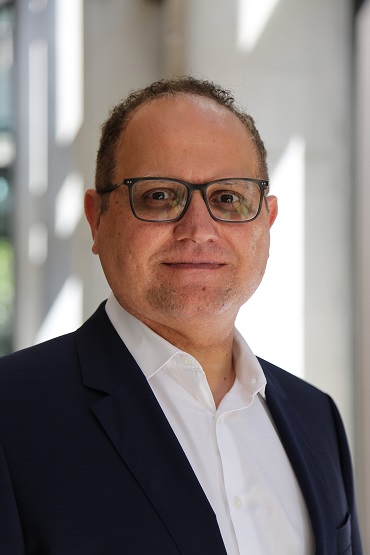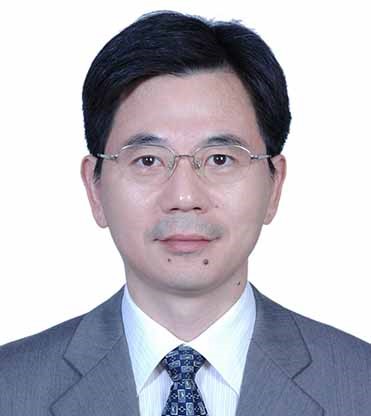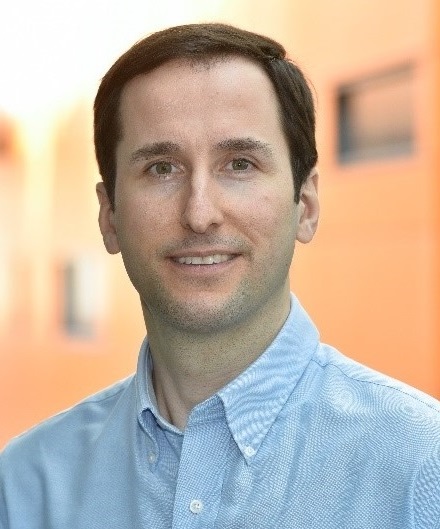|
Smart and Adaptive 4D Materials – Hierarchical Manufacturing
Hani Naguib
Abstract: Smart materials related research and applications have grown tremendously in the past couple of decades. The emergence of natural and synthetic smart materials possessing a set of desired properties, along with the development of novel processing techniques and a willingness of competitive manufacturers to adopt new materials has resulted in new smart materials components replacing the roles of traditional materials. Smart materials can also offer several benefits as components in adaptive and multifunctional materials. This seminar presents the design and hierarchical manufacturing of smart materials to achieve active 4D and multifunctional materials that are capable of sensing and responding to external stimuli with time. Examples of smart materials used in this study are shape-memory materials, piezoelectric and thermoelectric hybrids with main applications in smart textiles, artificial muscles and energy harvesting.
Biography: Professor Hani Naguib is a Professor at the University of Toronto, and director of the Toronto Institute for Advanced Manufacturing. His major expertise is in the area of manufacturing of smart materials and systems including: electro-active materials, metamaterials, and biomaterials. Naguib is the recipient of many honours and awards such as the Canada Research Chair, the Premier’s Early Research Award of Ontario, the Canada Foundation of Innovation, and the faculty Early Teaching Award. He is a Professional Engineer in Canada, a Chartered Engineer in U.K., a Fellow of the Institute of Materials Minerals and Mining IOM3, the American Society of Mechanical Engineers ASME, the Society of Plastics Engineers SPE, the Canadian Society of Mechanical Engineers CSME, and the International Society for Optics and Photonics SPIE. Dr. Naguib is serving as Associate Editor for the IOP Journal of Smart Materials and Structures, Journal of Cellular Plastics and Cellular Polymers.
|
|
Acoustic Black Hole Structures and their Applications in Vibration Damping and Noise Reduction
Jinhao QIU
Abstract: Acoustic black hole (ABH) effect utilizes the gradient variance of the structural configuration or material properties to realize the diminishing wave velocity in the structure. The wave velocity decreases to zero in an ideal scenario, resulting in zero reflection. The main method to realize the ABH structure is to adjust the structure through proper thickness tailoring in order to achieve energy capture in a certain area. It shows great advantages and potential application for flexural wave manipulation in thin-walled structure because of its high efficiency, broadband characteristic and flexible implementation. In this talk, the recent progress in modeling, analysis, implementation and measurement of ABH structures and their applications in wave manipulation, vibration damping and noise reduction is introduced. The topics in modeling, analysis, implementation and measurement of ABH structures include semi-analytical wavelet method for one-dimensional ABHs, FEM methods for two-dimensional ABHs and wave field visualization based on laser ultrasonic method. Applications of ABH structures include enhancement of energy harvesting, vibration damping based on energy focalization and ABH-based wide-band dynamic vibration absorber. Examples of cavity noise reduction using ABH panel is also introduced. Finally, the implementation of a one-dimensional ABH based on material stiffness gradation is demonstrated.
Biography: Professor Jinhao Qiu is Deputy Director, State Key Laboratory of Mechanics and Control of Mechanical Systems. He received the Bachelor and Master degrees in mechanical engineering from Nanjing University of Aeronautics and Astronautics, China, in 1983 and 1986 respectively, and the PhD degree in mechanical engineering from Tohoku University, Japan in 1996. He was a research associate from 1986 to 1989 and lecturer 1990 to 1991 at Department of Mechanical Engineering, Nanjing University of Aeronautics and Astronautics. He was a faculty member at the Institute of Fluid Science, Tohoku University from 1992 to 2006, where he was a research associate from 1992 to 1998, an assistant professor 1998 to 2000, an associate professor from 2000 to 2004 and a professor from 2004 to 2006. Since March, 2006, he is a Changjiang Chair Professor at the Nanjing University of Aeronautics and Astronautics. In 2011, he was selected to “The Recruitment Program of Global Experts”. His main research interest is smart materials and structural systems, including development of piezoelectric materials and devices, vibration and noise control, structural health monitoring, and non-destructive testing. He has published more than 300 journal papers (including more than 230 SCI-indexed journal papers), 12 review papers, and more than 260 conference papers. He has also received 8 awards, including The 2002 Annual Dynamics, Measurement and Control Awards for Pioneering Achievements in the research of smart materials and structural systems from The Japan Society of Mechanical Engineers. He is the associate editor of Journal of Intelligent Material Systems and Structure, member of the editorial board of International Journal of Applied Electromagnetics and Mechanics and other four journals. He became ASME Fellow in 2014.
|
|
Integrated Design of Magnetorheological Fluid and Energy Absorbers for Optimal System Performance
Norman Wereley
Abstract: The ability to dissipate energy in vehicle systems, especially with the goal of protecting occupants from potentially injurious vibration, repetitive shock, crash and blast loads, is becoming a critical issue as the cumulative impact of these load spectra on chronic health and acute injury are becoming better understood. Typically, adaptive vibration and shock mitigation systems have utilized commercial-off-the-shelf magnetorheological fluids (MRFs) with specified properties as opposed to properties that are optimized for the particular application. The objective of this talk is to discuss what properties are optimal for a number of particular applications such as vibration isolation, shock load mitigation, or earthquake hazard mitigation. A number of key nondimensional parameters can be used to gain insight into how to define optimality for various applications including: Bingham number, Hedstrom number, Reynolds number, Mason number, dynamic range. Also, the trade-offs associated in designing an optimal MRF for a particular application are discussed. These trade-offs are illustrated using case studies from analytical, experimental and CFD studies.
Biography: Professor Norman Wereley‘s current research interests are focused on active and passive vibration and shock mitigation (especially occupant protection systems) using primarily magnetorheological materials, and soft actuators and soft robotic systems. Dr. Wereley has published over 220 journal articles, 16 book chapters, over 275 conference articles, and 20 patents. Dr. Wereley is Editor of the Journal of Intelligent Material Systems and Structures and associate editor of Smart Materials and Structures. He is the recipient of the ASME Adaptive Structures and Materials Systems. Dr. Wereley is the recipient of the ASME Adaptive Structures and Material Systems Prize (2012) and the SPIE Smart Structures and Materials Lifetime Achievement Award (2013). Dr. Wereley is a Fellow of AIAA, AHS, ASME, SPIE, and the Institute of Physics. He is also a Senior Member of IEEE. Dr. Wereley has a B.Eng. (1982) from McGill University and M.S. (1987) and Ph.D. (1990) from the Massachusetts Institute of Technology.
|
|
Design of multifunctional composites and their advanced additive manufacturing
Daniel Therriault
Abstract: The manufacturing of smart composites composed of various functional components and built-in sensors is a serious technological challenge. Additive manufacturing (or 3D printing), known as a family of processes that joins materials to fabricate objects in a layer-by-layer fashion, is a powerful approach for the manufacturing of multifunctional systems. This talk presents an overview of our current research effort on the design of smart composites and the development of advanced additive manufacturing platforms featuring multi-material printing and robotic positioning systems. Examples of polymer-based composites featuring high mechanical stiffness and high temperature resistance, high electrical conductivity, piezoelectricity and printed structures with noise attenuation will be presented. The targeted applications are oriented toward the transportation, aerospace, microelectronics and biomedical fields.
Biography: Professor Daniel Therriault is a full professor in the Mechanical Engineering Department at Polytechnique Montreal. He currently holds two Chairs: a Canada Research Chair on the fabrication of advanced microsystems and materials, and the Safran-Polytechnique Industrial Chair on the additive manufacturing of reinforced polymers. He is co-director of the Laboratory for Multiscale Mechanics (LM2). His research interests are mainly related to additive manufacturing of advanced materials and multifunctional composites. Past contributions include the development of innovative additive manufacturing processes (e.g., freeform printing), the design and fabrication of nanocomposite materials for advanced aerospace applications, the 3D printing of carbon fiber-reinforced thermoplastic composites, etc. Several important scientific contributions (~80 refereed papers) in prestigious journals such as Nature materials, Advanced Materials and Small, and multiple innovations (7 Patents) originated from the research activities of Prof. Therriault’s research team. He worked or is working on many collaborative research projects with partners such as Safran Group, Bombardier, Bell Textron Helicopter, 3M, Hutchinson, and the Canadian Space Agency. His current team is currently composed of 3 full-time RA, 1 part-time technician, 4 PDF, 10 PhD, 7 MS, and several undergraduate students.
|




